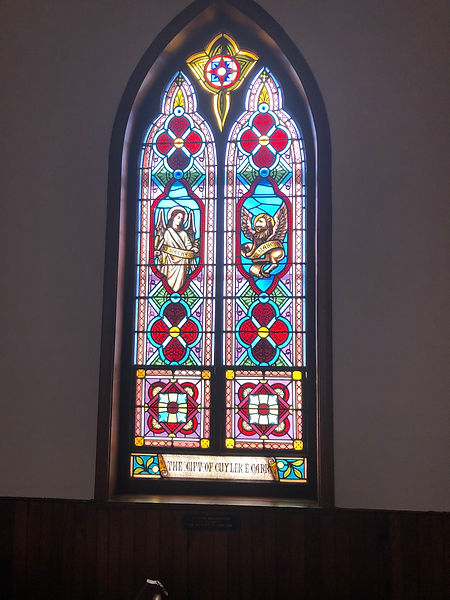Historic Stained Glass Windows
The interior of Evangelical Lutheran Church is illuminated by a series of antique stained glass windows, created by H. Stellwagon of Philadelphia in 1887.

The Altar Window is composed of a large triangle within a circle. Imposed upon the triangle are three circles emanating from a full circle in the middle of the window. The equilateral triangle with the letters "P", "F", "SS" in equal size circles at its points symbolizes the HOLY TRINITY and are probably its first symbolic form. The three equal sized circles at its points with the letters "P", "F", and "SS" express the doctrine of equality of the TRINITY. The letter "P" is Pater or Father; the letter "F" is Filuis or "Son"; and the letters "SS" are Spiritus Sanctus or "Holy Spirit". The three circles express the equality of the TRINITY.
The symbolism of the Descending Dove within the top circle is that of the HOLY GHOST.
The Chalice and Host in the lower right circle symbolizes the LORD'S SUPPER. The Chalice has a six-sided base which symbolizes the Six Attributes of the DEITY; Power, Wisdom, Majesty, Love, Mercy, and Justice. The Host is shown as a circular wafer rising out of the Chalice upon which the letters IHS are on it and rays of light emanate from the wafer which symbolizes the Real Presence of our LORD, in the bread and wine.
The Baptismal Font is depicted in the lower left circle as an octagonal or six sided font which is the symbol of regeneration. The Font expresses the congregation's belief in Holy Baptism. The Cross arising from the Font symbolizes self dedication to CHRIST. The Crown and Cross in the center circle symbolize Victory. The circle which surrounds all the symbols is symbolic of the eternal existence of GOD since it has neither a beginning nor an end. It also symbolizes the Unity of the Godhead.

North Side Window #1
The Sheaf of Wheat symbolizes Plenty, gifts of GOD, the bounty of GOD. The wheat heads also symbolize The Bread of Life and of Holy Communion. The Grapes and Vine symbolize the Holy Eucharist. When used with the Vine it means, "I am the vine, ye are the branches".

North Side Window #2
The Anchor entwined with Hope and Safety -- "Which hope we have as an anchor of the soul". The Cross is entwined with "Bear you one another's burdens".

North Side Window #3
The Cross with "I.H.S." imposed upon it symbolizes JESUS on the Cross. It is the first three letters of the Greek word for JESUS. The Cross with Alpha and Omega imposed upon it are the first and last letters of the Greek alphabet, telling us that CHRIST is he beginning and ending of life.

North Side Window #4
The Winged Ox with radiant nimbus and St. Luca symbolizes St. Luke's Gospel which gives the fullest account of our LORD JESUS CHRIST dying on the Cross. The Winged Eagle with a radiant nimbus and St. Johannas symbolizes St. John, for his Gospel will soar Heavenward.

South Side Window #1
The six sided Baptismal Font is the expression of our belief in Holy Baptism. The six sided or octagon Font is a symbol of regeneration. The Chalice is the symbol for the Lord's Supper, the Cross arising from the Chalice symbolizes one's dedication to CHRIST.

South Side Window #2
The Palm Tree entwined with "The righteous shall flourish like a Palm Tree". It symbolizes Victory. The Lily entwined with "Behold the lilies of the field" symbolizes the VIRGIN MARY, purity, innocence and heavenly bliss.

South Side Window #3
The Crown with a Cross inside symbolizes Victory. In Revelation 2, "The Crown of Life" refers to eternal life through our LORD JESUS CHRIST. The Cross with crossed trumpets imposed on it, Revelation 1 "I was in the Spirit of the Lord's day, and heard behind me a great voice of a trumpet".

South Side Window #4
The Winged figure with a radiant nimbus and St. Mathaus symbolizes St. Matthew's Gospel which begins with the human ancestry of CHRIST. The Winged Lion with a radiant nimbus and St. Marcus symbolizes St. Mark's Gospel which opens with "The voice of one crying in the wilderness".
Researched by Robert Geberth with the help of notes collected and preserved by Mrs. Faith Buechner.
Notes from Rev. Edwin A. Lehr were helpful in compiling the symbolism and meaning of the altar window.
Originally published by Evangelical Lutheran Church 4/15/16